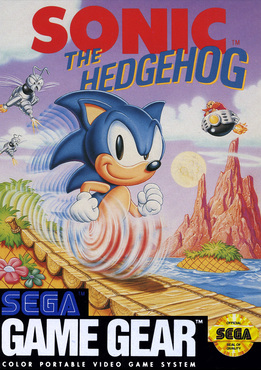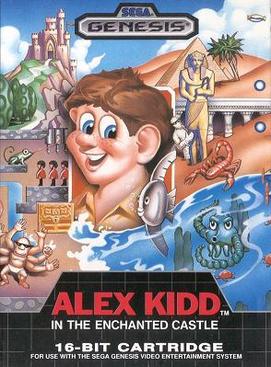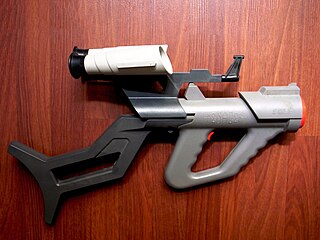
A platformer is a sub-genre of action video games in which the core objective is to move the player character between points in an environment. Platform games are characterized by levels with uneven terrain and suspended platforms of varying height that require jumping and climbing to traverse. Other acrobatic maneuvers may factor into the gameplay, such as swinging from vines or grappling hooks, jumping off walls, gliding through the air, or bouncing from springboards or trampolines.

Ghouls 'n Ghosts, known as Dai Makaimura in Japan, is a side-scrolling platform game developed by Capcom, released as an arcade video game in 1988 and ported to home platforms. It is the sequel to Ghosts 'n Goblins and the second game in the Ghosts 'n Goblins series.

Sonic the Hedgehog is a 1991 platform game. It is a companion to the 16-bit Sega Genesis game Sonic the Hedgehog for the 8-bit Sega Master System and Game Gear consoles. Ancient—a studio founded by composer Yuzo Koshiro for the project—developed the game and Sega published it to promote the handheld Game Gear. The 8-bit Sonic is a side-scrolling game similar in style to the 16-bit game, but reduced in complexity to fit the 8-bit systems.

Ristar is a 1995 platform game developed and published by Sega for the Sega Genesis. The game stars an anthropomorphic cartoon star who uses his hands and long, stretchable arms to both move and fight enemies. Reception for the game was generally positive, but the game's initial release was overshadowed due to the imminent ending of the Genesis's lifecycle and the succession of the Sega Saturn and other fifth generation video game consoles.

Sonic & Knuckles is a 1994 platform game developed and published by Sega. Players control Sonic the Hedgehog or Knuckles the Echidna in their quests to save Angel Island; Sonic tries to stop Doctor Robotnik from re-launching his orbital weapon, the Death Egg, while Knuckles scuffles with Robotnik's minion, EggRobo. Like previous Sonic games, players traverse side-scrolling levels at high speeds while collecting rings and defeating enemies.

Altered Beast is a 1988 beat 'em up arcade video game developed and published by Sega. The game is set in Ancient Greece and follows a player character chosen by Zeus to rescue his daughter Athena from the demonic ruler of the underworld, Neff. By collecting three power-ups in a level, the player character transforms into one of five magical beasts. It was ported to several home video game consoles and home computers. Altered Beast was the pack-in game when the Genesis launched in North America and the Mega Drive in Europe.

Alex Kidd in the Enchanted Castle is a side-scrolling platform game developed and published by Sega for the Genesis. It is the only 16-bit platform game starring Alex Kidd, and the fifth game in the Alex Kidd series of video games.

Sonic the Hedgehog: Triple Trouble is a 1994 platform game developed by Aspect and published by Sega for the Game Gear. It is the sequel to Sonic Chaos (1993) and features classic side-scrolling Sonic gameplay. The player controls either Sonic the Hedgehog or Miles "Tails" Prower as they venture to protect the powerful Chaos Emeralds from Doctor Robotnik, Knuckles the Echidna, and series newcomer Nack the Weasel. Sonic and Tails' unique abilities, as well as various power-ups, can assist the player in gameplay.

ToeJam & Earl is a 1991 action video game developed by Johnson Voorsanger Productions and published by Sega for the Genesis console. It centers on ToeJam and Earl—alien rappers who have crash-landed on Earth—as they attempt to escape the planet, players assume the role of either character and collect pieces of their wrecked spacecraft. It references and parodies 1980s and early 90s urban culture and is set to a funk soundtrack. ToeJam & Earl's design was heavily influenced by the role-playing video game Rogue (1980) and derived various features from the game, such as the random generation of levels and items. As such, ToeJam & Earl is often considered to be an example of a roguelike game.

The Menacer is a light gun peripheral released by Sega in 1992 for its Sega Genesis and Sega CD video game consoles. It was created in response to Nintendo's Super Scope and as Sega's successor to the Master System Light Phaser. The gun is built from three detachable parts, and communicates with the television via an infrared sensor. The Menacer was announced at the May 1992 Consumer Electronics Show in Chicago and was released later that year. The gun was bundled with a pack-in six-game cartridge of mostly shooting gallery games. Sega also released a Menacer bundle with Terminator 2: The Arcade Game.

Splatterhouse 2, known in Japan as Splatterhouse Part 2, is a beat 'em up video game developed by Now Production and published by Namco for the Sega Genesis in 1992. It is the sequel to Splatterhouse, as well as the third installment of the Splatterhouse video game series, following Splatterhouse: Wanpaku Graffiti.

Super Fantasy Zone is a scrolling shooter video game developed and published by Sunsoft for the Mega Drive. Part of Sega's Fantasy Zone series, it was released only in Japan and Europe. Players control the character Opa-Opa on his quest to defeat Dark Menon, and the game plays similarly to previous Fantasy Zone entries. The game plays similarly to Defender, where the screen scrolls in the direction that Opa-Opa is going. The player shoots at enemies to defeat them, collecting gold coins that are used to purchase temporary upgrades that improve Opa-Opa's offensive capabilities and speed, among other things.
A side-scrolling video game is a game viewed from a side-view camera angle where the screen follows the player as they move left or right. The jump from single-screen or flip-screen graphics to scrolling graphics during the golden age of arcade games was a pivotal leap in game design, comparable to the move to 3D graphics during the fifth generation.

ToeJam & Earl Productions, Inc. (1989–2003) was an American video game company founded by Electronic Arts developers Mark Voorsanger and Greg Johnson. Their best-known titles were Orly's Draw-A-Story, and three games in the ToeJam & Earl series.

MUSHA is a vertically scrolling shooter developed by Compile and released for the Sega Genesis in 1990. An entry in Compile's shooter series, Aleste, MUSHA places the player in the role of a flying mecha pilot who must destroy a large super intelligent computer threatening planet Earth. The game had a working title of Aleste 2 and originally featured a style similar to the first game, but this was changed to a more original Japanese aesthetic and speed metal soundtrack.

ToeJam & Earl III: Mission to Earth is an action video game released for the Xbox on October 22, 2002. Developed by ToeJam & Earl Productions and Visual Concepts, and published by Sega, it is the third installment in the ToeJam & Earl series. Players assume the role of one of three extraterrestrial protagonists: ToeJam and Earl, who starred in the series' first two games, and Latisha, a new character. While using power-ups to combat enemies, players seek to collect the twelve "Sacred Albums of Funk" and defeat the antagonistic "Anti-Funk."

Sonic & Sega All-Stars Racing is a 2010 kart racing video game developed by Sumo Digital and published by Sega. It was released for Wii, Xbox 360, PlayStation 3, Nintendo DS, and Windows, featuring characters from multiple Sega franchises. The game is the third title in the Sega All-Stars series, preceded by Sega Superstars Tennis. A mobile version was developed by Gameloft, and released for iOS in June 2011, as a paid download. A version for OS X was released by Feral Interactive in April 2013.
Greg Johnson is an American video game designer known for the ToeJam & Earl and Starflight games. He has worked for Binary Systems and Electronic Arts and co-founded ToeJam & Earl Productions with Mark Voorsange. In 2006, he founded HumaNature Studios. His game credits include Orly's Draw-A-Story (1997), Kung Fu Panda World (2010), and Doki-Doki Universe (2013).

ToeJam & Earl: Back in the Groove is the fourth entry in the ToeJam & Earl series of video games. The game was developed by HumaNature Studios, founded by series creator Greg Johnson, and published by the studio on March 1, 2019.


















